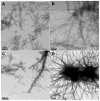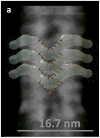Self-assembly of filamentous amelogenin requires calcium and phosphate: from dimers via nanoribbons to fibrils
- PMID: 22974364
- PMCID: PMC3496023
- DOI: 10.1021/bm300942c
Self-assembly of filamentous amelogenin requires calcium and phosphate: from dimers via nanoribbons to fibrils
Abstract
Enamel matrix self-assembly has long been suggested as the driving force behind aligned nanofibrous hydroxyapatite formation. We tested if amelogenin, the main enamel matrix protein, can self-assemble into ribbon-like structures in physiologic solutions. Ribbons 17 nm wide were observed to grow several micrometers in length, requiring calcium, phosphate, and pH 4.0-6.0. The pH range suggests that the formation of ion bridges through protonated histidine residues is essential to self-assembly, supported by a statistical analysis of 212 phosphate-binding proteins predicting 12 phosphate-binding histidines. Thermophoretic analysis verified the importance of calcium and phosphate in self-assembly. X-ray scattering characterized amelogenin dimers with dimensions fitting the cross-section of the amelogenin ribbon, leading to the hypothesis that antiparallel dimers are the building blocks of the ribbons. Over 5-7 days, ribbons self-organized into bundles composed of aligned ribbons mimicking the structure of enamel crystallites in enamel rods. These observations confirm reports of filamentous organic components in developing enamel and provide a new model for matrix-templated enamel mineralization.
Figures






Similar articles
-
Self-aligning amelogenin nanoribbons in oil-water system.J Struct Biol. 2011 Apr;174(1):203-12. doi: 10.1016/j.jsb.2010.11.027. Epub 2010 Dec 4. J Struct Biol. 2011. PMID: 21134461 Free PMC article.
-
Mechanisms of Enamel Mineralization Guided by Amelogenin Nanoribbons.J Dent Res. 2021 Dec;100(13):1434-1443. doi: 10.1177/00220345211012925. Epub 2021 May 19. J Dent Res. 2021. PMID: 34009057 Free PMC article. Review.
-
Matching 4.7-Å XRD spacing in amelogenin nanoribbons and enamel matrix.J Dent Res. 2014 Sep;93(9):918-22. doi: 10.1177/0022034514544216. Epub 2014 Jul 21. J Dent Res. 2014. PMID: 25048248 Free PMC article.
-
Progression of Self-Assembly of Amelogenin Protein Supramolecular Structures in Simulated Enamel Fluid.Biomacromolecules. 2018 Oct 8;19(10):3917-3924. doi: 10.1021/acs.biomac.8b00808. Epub 2018 Aug 30. Biomacromolecules. 2018. PMID: 30114917 Free PMC article.
-
Controls of nature: Secondary, tertiary, and quaternary structure of the enamel protein amelogenin in solution and on hydroxyapatite.J Struct Biol. 2020 Dec 1;212(3):107630. doi: 10.1016/j.jsb.2020.107630. Epub 2020 Sep 24. J Struct Biol. 2020. PMID: 32979496 Free PMC article. Review.
Cited by
-
The proteolytic processing of amelogenin by enamel matrix metalloproteinase (MMP-20) is controlled by mineral ions.Biochim Biophys Acta. 2013 Mar;1830(3):2600-7. doi: 10.1016/j.bbagen.2012.11.021. Biochim Biophys Acta. 2013. PMID: 23201201 Free PMC article.
-
Amelogenin in Enamel Tissue Engineering.Adv Exp Med Biol. 2015;881:237-54. doi: 10.1007/978-3-319-22345-2_13. Adv Exp Med Biol. 2015. PMID: 26545753 Free PMC article.
-
Cloning and Expression Analysis of Human Amelogenin in Nicotiana benthamiana Plants by Means of a Transient Expression System.Mol Biotechnol. 2017 Oct;59(9-10):425-434. doi: 10.1007/s12033-017-0030-y. Mol Biotechnol. 2017. PMID: 28801830
-
SAXS of murine amelogenin identifies a persistent dimeric species from pH 5.0 to 8.0.J Struct Biol. 2024 Dec;216(4):108131. doi: 10.1016/j.jsb.2024.108131. Epub 2024 Oct 4. J Struct Biol. 2024. PMID: 39368677
-
The role of the TGF-β1 signaling pathway in the process of amelogenesis.Front Physiol. 2025 Apr 9;16:1586769. doi: 10.3389/fphys.2025.1586769. eCollection 2025. Front Physiol. 2025. PMID: 40271211 Free PMC article. Review.
References
-
- Smith KH, Tejeda-Montes E, Poch M, Mata A. Chem Soc Rev. 2011;40:4563–4577. - PubMed
-
- Ingber DE. Sci Am. 1998;278:48–57. - PubMed
-
- Warshawsky H. Anat Rec. 1989;224:242–262. - PubMed
-
- White SN, Luo W, Paine ML, Fong H, Sarikaya M, Snead ML. J Dent Res. 2001;80:321–326. - PubMed
-
- Smith CE. Crit Rev Oral Biol Med. 1998;9:128–161. - PubMed

